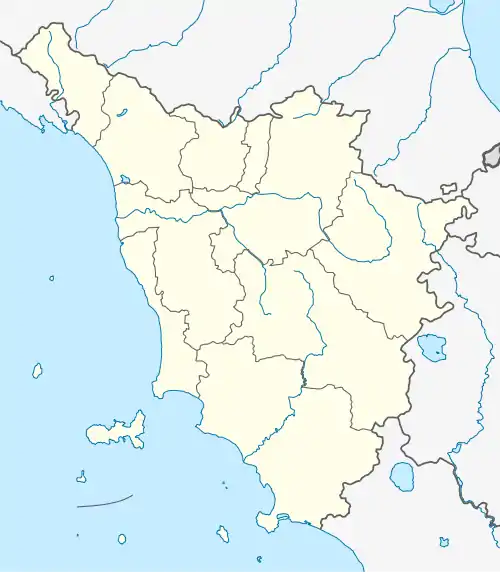Roccalbegna
Roccalbegna is a comune (municipality) in the Province of Grosseto in the Italian region Tuscany, located about 110 kilometres (68 mi) south of Florence and about 35 kilometres (22 mi) east of Grosseto.
Roccalbegna | |
|---|---|
| Comune di Roccalbegna | |
 | |
 Coat of arms | |
Location of Roccalbegna | |
 Roccalbegna Location of Roccalbegna in Italy  Roccalbegna Roccalbegna (Tuscany) | |
| Coordinates: 42°47′N 11°30′E | |
| Country | Italy |
| Region | Tuscany |
| Province | Grosseto (GR) |
| Frazioni | Cana, Santa Caterina, Triana, Vallerona |
| Government | |
| • Mayor | Massimo Galli |
| Area | |
| • Total | 124.86 km2 (48.21 sq mi) |
| Elevation | 522 m (1,713 ft) |
| Population (1 January 2022)[2] | |
| • Total | 921 |
| • Density | 7.4/km2 (19/sq mi) |
| Demonym(s) | Roccalbegnini, Rocchigiani |
| Time zone | UTC+1 (CET) |
| • Summer (DST) | UTC+2 (CEST) |
| Postal code | 58053 |
| Dialing code | 0564 |
| Patron saint | St. Christopher |
| Saint day | 25 July |
| Website | Official website |
History
Roccalbegna was a fief of the Aldobrandeschi in the Middle Ages; later it was part of the Republic of Siena, until the latter's fall in the hands of the Medici, who sold the town to the County of Santa Fiora. In the 18th century it was returned to the Grand Duchy of Tuscany.
Frazioni
The municipality is formed by the municipal seat of Roccalbegna and the villages (frazioni) of Cana, Santa Caterina, Triana and Vallerona.
Main sights

Roccalbegna is home to several notable fortifications, such as the Cassero Senese (built in the 13th century by the Aldobrandeschi, renovated in the 15th century) and the Rocca Aldobrandesca, located on the hill overlooking the town and the Albegna river (whence the town's name). Outside the town there is the large castle of Triana (known from 760), also owned by the Aldobrandeschi and then by the Sforza of Santa Fiora; it has maintained its medieval line of walls. The hamlet of Cana has also an Aldobrandeschi-built line of walls from the 13th century.
Also notable is the Romanesque-Gothic church of Santi Pietro e Paolo (13th-14th centuries, modified in the 18th century). It has a large Gothic portal surmounted by a rose window. It houses some parts of a polyptych by Ambrogio Lorenzetti (c. 1340), a Pietà by Alessandro Casolani and a 15th-century small fresc of Madonna with Saints.
References
- "Superficie di Comuni Province e Regioni italiane al 9 ottobre 2011". Italian National Institute of Statistics. Retrieved 16 March 2019.
- All demographics and other statistics: Italian statistical institute Istat.